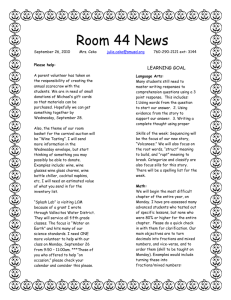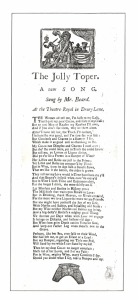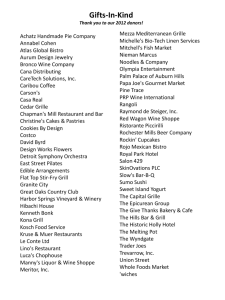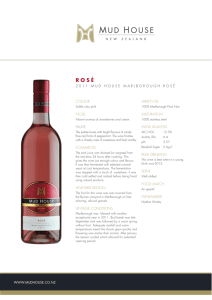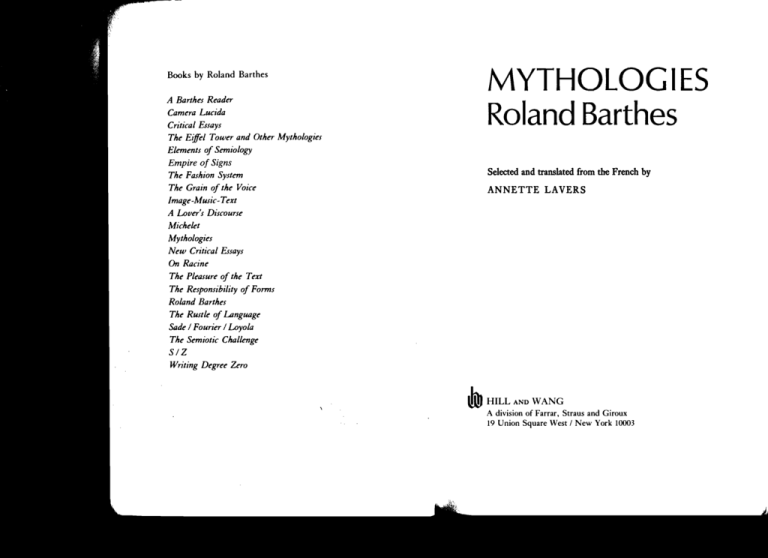
Books by Roland Barthes
A Barthes Reader
Camera Lucida
Critical Essays
The EijJel Tower and Other Mythologies
Elements of Semiology
MYTHOLOGIES
Roland Barthes
Empire of Signs
The Fashion System
The Grain of the Voice
Image-Music- Text
A Lover's Discourse
Michelet
Mythologies
New Critical Essays
On Racine
The Pleasure of the Text
The Responsibility of Forms
Roland Barthes
The Rustle of Language
Sade / Fourier / Loyola
The Semiotic Challenge
S/Z
Writing Degree Zero
Selected and translated from the French by
ANNETTE LAVERS
lIDJ HILL AND WANG
A division of Farrar, Straus and Giroux
19 Union Square West / New York 10003
Translated from the French Mythologies
© 1957 by Editions du Seuil, Paris
Translation © 1972 by Jonathan Cape Ltd.
All rights reserved
Published in Canada by HarperCollinsCanadaLtd
Printed in the United States of America
Library of Congress catalog card number: 75-185427
First published in 1972 by Hill and Wang,
a division of Farrar, Straus and Giroux
Twenty-ninth printing. 1995
Of the essays reproduced in this book, "The World of
Wrestling" first appeared in Esprit, "The Writer on
Holiday" in France-Observateur, and the remainder
in Les Lettres Nouvelles.
Contents
TRANSLATOR'S NOTE
7
PREFACE TO THE 1970 EDITION
PREFACE-TO THE
1957
EDITION
MYTHOLOGIES
The World of Wrestling
The Romans in Films
The Writer on Holiday
The 'Blue Blood' Cruise
Blind and Dumb Criticism
Soap-powders and Detergents
The Poor and the Proletariat
Operation Margarine
Dominici, or the Triumph of Literature
The Iconography of the Abbe Pierre
Novels and Children
Toys
The Face of Garbo
Wine and Milk
Steak and Chips
The Nautilus and the Drunken Boat
The Brain of Einstein
The Jet-man
The Blue Guide
Ornamental Cookery
Neither-Nor Criticism
Striptease
The New Citroen
Photography and Electoral Appeal
The Lost Continent
Plastic
9
II
IS
26
29
32
34
36
39
41
43
47
5°
53
56
58
62
65
68
71
74
78
81
84
88
91
94
97
CONTENTS
The Great Family of Man
100
The Lady of the Camel/ias
103
MYTH TODAY
109
Myth;s a type of speech-Myth as a semiological system
The form and the concept- The signification
Reading and deciphering myth-Myth as stolen language
The bourgeoisie as a joint-stock company
Myth is depoliticized speech-Myth on the Left
Myth on the Right-Necessity and limits ofmythology
Translator's Note
The style of Mythologies, which strikes one at first as being highly
poetic and idiosyncratic, later reveals a quasi-technical use of
certain termS. This is in part due to an effort to account for the
phenomena of mass culture by resorting to new models.
First and foremost among such models, as indicated in the
Preface, is linguistics, whose mark is seen not so much in the use
of a specialized vocabulary as in the extension to other fields of
words normally reserved for speech or writing, such as transcrip­
tion, retort, reading, univocal (all used in connection with
wrestling), or to decipher (plastics or the 'good French Wine').
The author's teaching is also associated with a rediscovery of
ancient rhetoric, which provides one of the connotations of the
word figure when it is used in connection with cooking or
wrestling.
Spectacle and gesture are often irreplaceable and refer to the
interplay of action, representation and alienation in man and
in society. Other terms belong to philosophical vocabulary,
whether traditional (e.g. substance, which also has echoes of
Bachelard and Hjelmslev), SartreanJMarxist (e.g. a paradox, a
car or a cathedral are said to be consumed by the public), or
recent (e.g. closure, which heralds the combinative approach of
semiology and its philosophical consequences). Transference
connotes the discoveries of psycho-analysis on the relations
between the abstract and the concrete. There is in addition a
somewhat humorous plea for a reasoned use of neologism (cf. pp.
120-21) which foreshadows later reflections on the mutual
support of linguistic and social conventions.
Such characteristics have been kept in the hope of retaining
some of the flavour of the original.
Finally, the author's footnotes are indicated by numerals, and
the translator's by asterisks.
7
WINE AND MILK
Wine and Milk
~
.
Wine is felt by the French nation to be a possession which is its
very own, just like its three hundred lind sixty types of cheese and
its culture. It is a totem-drink, corresponding to the milk of the
Dutch cow or the tea ceremonially taken by the British Royal
Family. Bachelard has already given the 'substantial psycho­
analysis' of this fluid, at the end of his essay on the reveries on the
theme of the will, and shown that wine is the sap of the sun and
the earth, that its basic state is not the moist but the dry, and that
on such grounds the substance which is most contrary to it is water.
Actually, like all resilient totems, wine supports a varied
mythology which does not trouble about contradictions. This
galvanic substance is always considered, for instance, as the
most efficient of thirst-quenchers, or at least this serves as the
major alibi for its consumption ('It's thirsty weather'). In its red
form, it has blood, the dense and vital fluid, as a very old hypo­
stasis. This is because in fact its humoral form matters little; it is
above all a converting substance, capable of reversing situations
and states, and of extracting from objects their opposites - for
instance, making a weak man strong or a silent one talkative.
Hence its old alchemical heredity, its philosophical power to
transmute and create ex nihilo.
Being essentially a function whose terms can change, wine has
at its disposal apparently plastic powers: it can serve as an alibi
to dr~m as well as reality, it depends on the users of the myth.
For the worker, wine means enabling him to do his task with
demiurgic ease ('heart for the work'). For the intellectual, wine
has the reverse function: the local white wine or the beaujolais
of the writer is meant to cut him off from the all too expected
environment of cocktails and expensive drinks (the only ones
which snobbishness leads one to offer him). Wine will deliver
him from myths, will remove some of his intellectualism,
will make him the equal of the proletarian; through wine, the
58
intellectual comes nearer to a natural virility, and believes he can
thus escape the curse that a century and a half of romanticism
still brings to bear on the purely cerebral (it is well known that
one of the myths peculiar to the modern intellectual is the
obsession to 'have it where it matters').
But what is characteristic of France is that the converting
power of wine is never openly presented as an end. Other coun­
tries drink to get drunk, and this is accepted by everyone; in
France, drunkenness is a consequence, never an intention. A
drink is felt as the spinning out of a pleasure, not as the necessary
cause of an effect which is sought: wine is not only a philtre, it is
also the leisurely act of drinking. The gesture has here a decorative
value, and the power of wine is never separated from its modes of
existence (unlike whisky, for example, which is drunk for its
type of drunkenness-'the most agreeable, with the least painful
after-effects' -which one gulps down repeatedly, and the
drinking of which is reduced to a causal act).
All this is well known and has been said a thousand times in
folklore, proverbs, conversations and Literature. But this very
universality implies a kind ofconformism : to believe in wine is a
coercive collective act. A Frenchman who kept this myth at
arm's length would expose himself to minor but definite problems
of integration, the first of which, precisely, would be that of
having to explain his attitude. The universality principle fully
applies here, inasmuch as society calls anyone who does not
believe in wine by names such as sick, disabled or depraved: it
does not comprehend him (in both senses, intellectual and
spatial, of the word). Conversely, an award of good integration is
given to whoever is a practising wine-drinker: knowing hOTlJ to
drink is a national technique which serves to qualify the French­
man, to demonstrate at once his performance, his control and his
sociability. Wine gives thus a foundation for a collective morality,
within which everything is redeemed: true, excesses, mis­
fortunes and crimes are possible with wine, but never viciousness,
treachery or baseness; the evil it can generate is in the nature of
fate and therefore escapes penalization, it evokes the theatre
rather than a basic temperament.
59
MYTHOLOGIES
Wine is a part of society because it provides a basis not only for
a morality but also for an environment; it is an ornament in the
slightest ceremonials of French daily life, from the snack (plonk
and camembert) to the feast, from the conversation at the local
cafe to the speech at a formal dinner. It exalts all climates, of
whatever kind: in cold weather, it is associated with all the
myths of becoming warm, and at the height of summer, with all
the images of shade, with all things cool and sparkling. There is
no situation involving some physical constraint (temperature,
hunger, boredom, compulsion, disorientation) which does not
give rise to dreams of wine. Combined as a basic substance with
other alimentary figures, it can cover all the aspects of space and
time for the Frenchman. As soon as one gets to know someone's
daily life fairly well, the absence of wine gives a sense of shock,
like something exotic: M. Coty, having allowed himself to be
photographed, at the beginning of his seven years' presidency,
sitting at home before a table on which a bottle of beer seemed to
replace, by an extraordinary exception, the familiar litre of red
wine, the whole nation was in a flutter; it was as intolerable as
having a bachelor king. Wine is here a part of the reason of state.
Bachelard was probably right in seeing water as the opposite
of wine: mythically, this is true; sociologically, today at least,
less so; economic and historical circumstances have given this
part to milk. The latter is now the true anti-wine: and not only
because of M. Mendes-France's popularizing efforts (which had a
purposely mythological look as when he used to drink milk
during his speeches in the Chamber, as Popeye eats spinach), but
also because in the basic morphology of substances milk is the
opposite of fire by all the denseness of its molecules, by the
creamy, and therefore soothing, nature of its spreading. Wine is
mutilating, surgical, it transmutes and delivers; milk is cosmetic,
it joins, covers, restores. Moreover, its purity, associated with
the innocence of the child, is a token of strength, of a strength
which is not revulsive, not congestive, but calm, white, lucid, the
equal of reality. Some American films, in which the hero, strong
and uncompromising, did not shrink from having a glass of milk
before drawing his avenging Colt, have paved the way for
60
WINE AND MILK
this new Parsifalian myth. A strange mixture of milk and
pomegranate, originating in America, is to this day sometimes
drunk in Paris, among gangsters and hoodlums. But milk re>­
mains an exotic substance; it is wine which is part of the nation.
The mythology of wine can in fact help us to understand the
usual ambiguity of our daily life. For it is true that wine is a good
and fine substance, but it is no less true that its production is
deeply involved in French capitalism, whether it is that of the
private distillers or that of the big settlers in Algeria who impose
on the Muslims, on the very land of which they have been dis­
possessed, a crop of which they have no need, while they lack
even bread. There are thus very engaging myths which are
however not innocent. And the characteristic of our current
alienation is precisely that wine cannot be an unalloyedly blissful
substance, except if we wrongfully forget that it is also the
product of an expropriation.
61
STEAK AND CHIPS
Steak and Chips
Steak is a part of the same sanguine mythology as wine. It is the
heart of meat, it is meat in its pure state; and whoever partakes
of it assimilates a bull-like strength. The prestige of steak
evidently derives from its quasi-rawness. In it, blood is visible,
natural, dense, at once compact and seetile. One can well imagine
the ambrosia of the Ancients as this kind of heavy substance
which dwindles under one's teeth in such a way as to make one
keenly aware at the same time of its original strength and of its
aptitude to flow into the very blood of man. Full-bloodedness is
the raison d'etre of steak; the degrees to which it is cooked are
expressed not in calorific units but in images of blood; rare steak
is said to be saignant (when it recalls the arterial flow from the
cut in the animal's throat), or bleu (and it is now the heavy,
plethoric, blood of the veins which is suggested by the purplish
colour-the superlative of redness). Its cooking, even moderate,
cannot openly find expression; for this unnatural state, a
euphemism is needed: one says that steak is point, 'medium',
and this in truth is understood more as a limit than as a per­
feetion.
To eat steak rare therefore represents both a nature and a
morality. It is supposed to benefit all the temperaments, the
sanguine because it is identical, the nervous and lymphatic
because it is complementary to them.· And just as wine becomes
for a good number of intellectuals a mediumistic substance which
leads them towards the original strength of nature, steak is for
them a redeeming food, thanks to which they bring their intel­
lectualism to the level of prose and exorcize, through blood and
soft pulp, the sterile dryness of which they are constantly accused.
The craze for steak tartare, for instance, is a magic spell against
the romantic association between sensitiveness and sickliness;
there are to be found, in this preparation, all the germinating
a
62
states of matter: the blood mash and the glair of eggs, a whole
harmony of soft and life-giving substances, a sort of meaningful
compendium of the images of pre-parturition.
Like wine, steak is in France a basic element, nationalized even
more than socialized. It figures in all the surroundings of
alimentary life: flat, edged with yellow, like the sole of a shoe, in
cheap restaurants; thick and juicy in the bistros which specialize
in it; cubic, with the core all moist throughout beneath a light
charred crust, in haute cuisine. It is a part ofall the rhythms, that
of the comfortable bourgeois meal and that of the bachelor's
bohemian snack. It is a food at once expeditious and dense, it
effects the best possible ratio between economy and efficacy,
between mythology and its multifarious ways of being consumed.
Moreover, it is a French possession (circumscribed today, it is
true, by the invasion of American steaks). As in the case of wine
there is no alimentary constraint which does not make the French­
man dream of steak. Hardly abroad, he feels nostalgia for it.
Steak is here adorned with a supplementary virtue of elegance,
for among the apparent complexity of exotic cooking, it is a food
which unites, one feels, succulence and simplicity. Being part of
the nation, it follows the index of patriotic values: it helps them to
rise in wartime, it is the very flesh of the French soldier, the
inalienable property which cannot go over to the enemy except
by treason. In an old film (Deuxieme Bureau contre Kommandan­
tur), the maid of the patriotic cure gives food to the Boche spy
disguised as a French underground fighter: 'Ah, it's you,
Laurent! /'// give you some steak.' And then, when the spy is
unmasked: 'And when I think I gave him some ofmy steak!' - the
supreme breach of trust.
Commonly associated with chips, steak communicates its
national glamour to them: chips are nostalgic and patriotic like
steak. Match told us that after the armistice in Indo-China
'General de Castries, for his first meal, asked for chips'. And the
President of the Indo-China Veterans, later commenting on this
information added: 'The gesture ofGeneral de Castries asking for
chips for his first meal has not always been understood.' What we
were meant to understand is that the General's request was
63
MYTHOLOGIES
certainly not a vulgar materialistic reflex, but an episode in the
ritual of appropriating the regained French community. The
General understood well our national symbolism; he knew that
la /rite, chips, are the alimentary sign of Frenchness.
The Nautilus and the Drunken Boat
The work of Jules Verne (whose centenary was recently cele­
brated) would be a good subject for a structural study: it is
highly thematic. Verne has built a kind of self-sufficient cosmo­
gony, which has its own categories, its own time, space, fulfilment
and even existential principle.
This principle, it seems to me, is the ceaseless action of
secluding oneself. Imagination about travel corresponds in
Verne to an exploration ofclosure, and the compatibility between
Verne and childhood does not stem from a banal mystique of
adventure, but on the contrary from a common delight in the
finite, which one also finds in children's passion for huts and
tents: to enclose oneself and to settle, such is the existential
dream of childhood and of Verne. The archetype of this dream is
this almost perfect novel: L'Ile myslb;euse, in which the man­
child re-invents the world, fills it, closes it, shuts himself up in
it, and crowns this encyclopaedic effort with the bourgeois
posture of appropriation; slippers, pipe and fireside, while
outside the storm, that is, the infinite, rages in vain.
Verne had an obsession for plenitude: he never stopped putting
a last touch to the world and furnishing it, making it full with an
egg-like fullness. His tendency is exactly that of an eighteenth­
century encyclopaedist or of a Dutch painter: the world is finite,
the world is full of numerable and contiguous objects. The
artist can have no other task than to make catalogues, inventories,
and to watch out for small unfilled comers in order to conjure up
there, in close ranks, the creations and the instruments of man.
Verne belongs to the progressive lineage of the bourgeoisie: his
work proclaims that nothing can escape man, that the world, even
its most distant part, is like an object in his hand, and that, all
told, property is but a dialectical moment in the general enslave­
ment of Nature. Verne in no way sought to enlarge the world by
romantic ways of escape or mystical plans to reach the infinite:
64
6S



